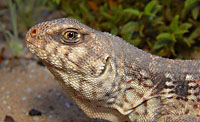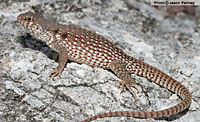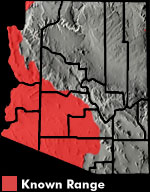Online Field Guide to The Reptiles and Amphibians of Arizona


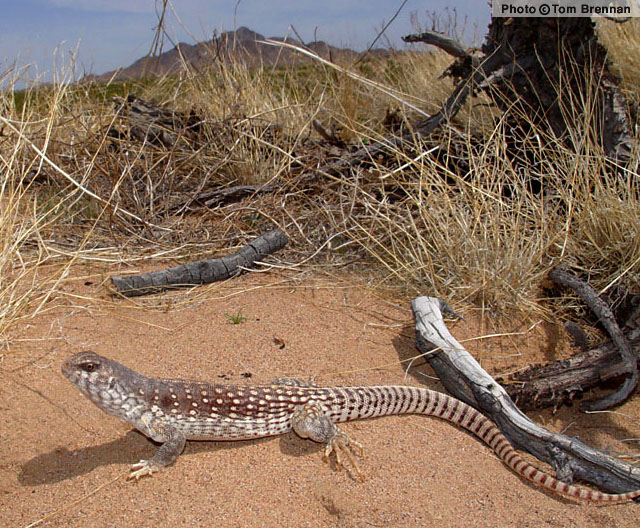
Yuma County, AZ
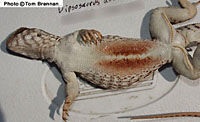 Yuma Co., AZ |
| DESERT IGUANA Dipsosaurus dorsalis | |
|
DESCRIPTION: A large (up to 146 mm or 5.75″ from snout to vent) lizard with a small, blunt head, a long tail, and short, stocky limbs. The tail is taller than it is wide. A single row of enlarged, pointed, protruding scales runs down the midline of the back. Base coloration on the back is gray-brown with white spots that are surrounded by reddish-brown reticulations. The reddish-brown reticulations become bands on the tail. The lower sides are cream with reddish-brown spots. The underside is pale cream. Adults have two large, rust patches on the belly during breeding season. The scales on the body are small and granular. HABITAT: This lizard is primarily an inhabitant of creosotebush dominated flatlands within Mohave Desertscrub and Lower Colorado River Sonoran Desertscrub communities. It is less commonly encountered above the flats in the more rocky and rugged Arizona Upland Sonoran Desertscrub community. Usually found in relatively open areas with sandy soil and plenty of room to run. BEHAVIOR: This heat tolerant diurnal lizard often remains active through mid-day when high temperatures force other lizards to seek shelter. It hibernates during the cold months of winter and late fall. This speedy lizard flees with an explosive burst of speed and often seeks shelter in a burrow when frightened. Primarily a ground dweller but often climbs into the branches of the creosotebush to reach the small yellow flowers (a favorite food item). DIET: Adults are primarily herbivorous. It also occasionally feeds on insects and carrion. Insects might make up a greater percentage of the diet of juveniles. REPRODUCTION: The Desert Iguana mates in spring and early summer and lays a clutch of up to 8 eggs in late spring or summer. REMARKS: This lizard is in the same family as the large green iguanas of Mexico and South America. By Thomas C. Brennan Brennan, T. C., & A. T. Holycross. 2006. A Field Guide to Amphibians and Reptiles in Arizona. Arizona Game and Fish Department. Phoenix, AZ Brennan, T. C., & A. T. Holycross. 2005. A Field Guide to Amphibians and Reptiles of Maricopa County. Arizona Game and Fish Department. Phoenix, AZ Stebbins, R.C. 2003. A Field Guide to Western Reptiles and Amphibians, Third Edition. Houghton Mifflin Company, Boston, MA. |
|
Visit Partners in Amphibian and Reptile Conservation:


HOME
Copyright © 2023, Arizona Game and Fish Department. All rights reserved.
If you make use of the textual contents of this site in reports, publications, etc. please cite and credit the author(s) and photographer(s). All photos on this website are copyrighted. However, those found in the species account section may be used for any noncommercial scientific, educational, or conservation purposes provided that photographs are not altered and continue to bear the copyright symbol and name of the photographer. Please contact the photographer regarding commercial use of copyrighted photographs.










